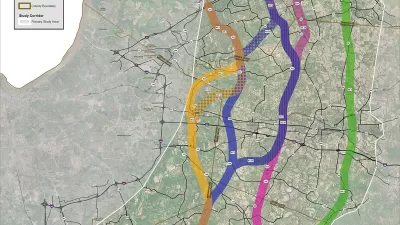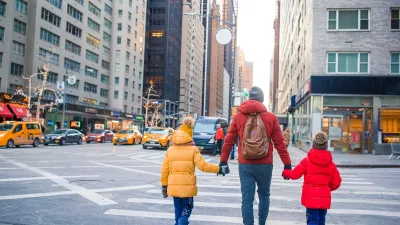The planned expansion of Interstate-5 in San Diego County would finally complete the Southern California metropolis. Los Angeles and Orange Counties became wall-to-wall sprawl development decades ago, erasing all traces of their rural heritage and the scenic outdoors. Northern San Diego County, with its quaint beach towns, is tenuously holding on to the last vestiges of agricultural land and breathable open space. But these areas too are rapidly developing. It is no surprise then that I-5, the only north-south route along the coast, is increasingly traffic clogged. The county’s solution? Invest $1.4 billion to expand the freeway from 8 lanes to 12 or 14 lanes along a 26-mile stretch of the north county coast.
The planned expansion of Interstate-5 in San Diego County would finally complete the Southern California metropolis. Los Angeles and Orange Counties became wall-to-wall sprawl development decades ago, erasing all traces of their rural heritage and the scenic outdoors. Northern San Diego County, with its quaint beach towns, is tenuously holding on to the last vestiges of agricultural land and breathable open space. But these areas too are rapidly developing. It is no surprise then that I-5, the only north-south route along the coast, is increasingly traffic clogged. The county's solution? Invest $1.4 billion to expand the freeway from 8 lanes to 12 or 14 lanes along a 26-mile stretch of the north county coast.
The county has good reasons for wanting to improve traffic flow in this region. With 10,000 daily truck trips, this is an important corridor for the transport of goods. It is also the main route for recreational travel between Los Angeles, San Diego and Mexico. However, the rush-hour congestion suggests that commuters contribute much of the additional traffic - one wonders just how many of those are driving 30 or 40 miles to work in San Diego.
Should taxpayers bear the burden of those who choose to live far from work and commute long distances by car? This $1.4 billion subsidy for the automobile, likely at the expense of rail and transit, will enhance the region's dependence on car travel. According to the California Air Resources Board, San Diego County is second only to Los Angeles County in many toxic vehicle-related air pollutants like benzene, formaldehyde and particulate matter. The widening of I-5 is not only a subsidy for polluters (commuters) but also a green light for further sprawl development. History shows that the benefits of the proposed highway enhancements won't last long – additional California road supply typically results in an increase in vehicle miles traveled and, ultimately, further increases in traffic.
Resources:
SANDAG – San Diego's Regional Planning Agency
California Air Resources Board - California Almanac of Emissions and Air Quality 2006
California Air Resources Board - Toxic Contaminant Emissions, Air Quality and Health Risk

Alabama: Trump Terminates Settlements for Black Communities Harmed By Raw Sewage
Trump deemed the landmark civil rights agreement “illegal DEI and environmental justice policy.”

Planetizen Federal Action Tracker
A weekly monitor of how Trump’s orders and actions are impacting planners and planning in America.

Why Should We Subsidize Public Transportation?
Many public transit agencies face financial stress due to rising costs, declining fare revenue, and declining subsidies. Transit advocates must provide a strong business case for increasing public transit funding.

Understanding Road Diets
An explainer from Momentum highlights the advantages of reducing vehicle lanes in favor of more bike, transit, and pedestrian infrastructure.

New California Law Regulates Warehouse Pollution
A new law tightens building and emissions regulations for large distribution warehouses to mitigate air pollution and traffic in surrounding communities.

Phoenix Announces Opening Date for Light Rail Extension
The South Central extension will connect South Phoenix to downtown and other major hubs starting on June 7.
Urban Design for Planners 1: Software Tools
This six-course series explores essential urban design concepts using open source software and equips planners with the tools they need to participate fully in the urban design process.
Planning for Universal Design
Learn the tools for implementing Universal Design in planning regulations.
Caltrans
Smith Gee Studio
Institute for Housing and Urban Development Studies (IHS)
City of Grandview
Harvard GSD Executive Education
Toledo-Lucas County Plan Commissions
Salt Lake City
NYU Wagner Graduate School of Public Service




























